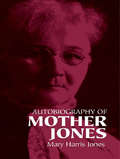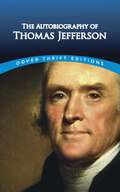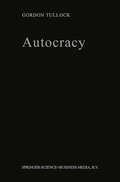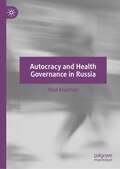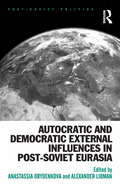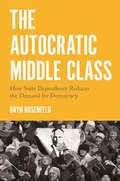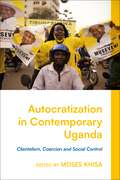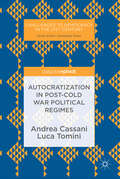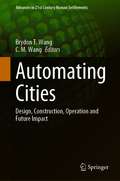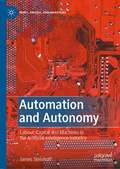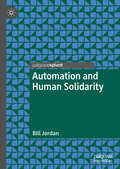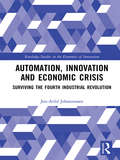- Table View
- List View
The Autobiography of Benjamin Franklin
by Benjamin FranklinOriginally intended as a guide for his son, Benjamin Franklin details his unique and eventful life as an inventor, writer, athlete, scientist, writer and diplomat.
The Autobiography of Eleanor Roosevelt
by Eleanor RooseveltEleanor Roosevelt stands as one of the world's greatest humanitarians, having dedicated her remarkable life to the liberty and equality of all people. In this sincere and frank self-portrait she recounts her childhood – marked by the death of her mother and separation from the rest of her family at age seven – her marriage to Franklin D. Roosevelt; and the challenges of motherhood, including the tragic death of her second son, all of which occurred before her twenty-fifth birthday.It wasn't till her thirties that Eleanor Roosevelt began the life for which she is known. A committed supporter of women's suffrage, architect of the welfare state, leader of the UN Commission on Human Rights and author of the Declaration of Human Rights, as well as being a prolific writer, diplomat, visionary, pacifist and committed social activist, hers is the story of the twentieth century.At once a heart-wrenching personal narrative and a unique historical document, The Autobiography of Eleanor Roosevelt is the ultimate example of the personal as political.
The Autobiography of Eleanor Roosevelt
by Eleanor RooseveltEleanor Roosevelt stands as one of the world's greatest humanitarians, having dedicated her remarkable life to the liberty and equality of all people. In this sincere and frank self-portrait she recounts her childhood – marked by the death of her mother and separation from the rest of her family at age seven – her marriage to Franklin D. Roosevelt; and the challenges of motherhood, including the tragic death of her second son, all of which occurred before her twenty-fifth birthday.It wasn't till her thirties that Eleanor Roosevelt began the life for which she is known. A committed supporter of women's suffrage, architect of the welfare state, leader of the UN Commission on Human Rights and author of the Declaration of Human Rights, as well as being a prolific writer, diplomat, visionary, pacifist and committed social activist, hers is the story of the twentieth century.At once a heart-wrenching personal narrative and a unique historical document, The Autobiography of Eleanor Roosevelt is the ultimate example of the personal as political.
Autobiography of Mother Jones
by Clarence Darrow Mary Field Parton Mary Harris JonesAmong the most stirring works of labor history ever written, this autobiography of Mother Jones (née Mary Harris) chronicles the life of a woman who was considered a saint by many, and by others, "the most dangerous woman in America." A forceful and picturesque figure in the American labor movement of the late nineteenth and early twentieth centuries, Mother Jones was a born crusader.Widowed at the age of 30 when her husband and four young children died during a yellow fever epidemic, Mother Jones spoke out tirelessly and effectively for the rights of workers and unionists. She played a significant role in organizing mining strikes in West Virginia and Colorado, as well as the Pittsburgh steel strike of 1919. She was instrumental in the formation of the United Mine Workers union (UMW) in 1890 and the Industrial Workers of the World (IWW) in 1905.
The Autobiography of Thomas Jefferson
by Thomas JeffersonDuring his remarkable lifetime, Thomas Jefferson (1743–1826) served his country in many capacities, including as the third President of the United States. But ultimately, this gifted individual — an accomplished architect, naturalist, and linguist — wished to be remembered primarily as the writer of the Declaration of Independence.In this autobiography, begun in 1821 when the author was 77, Jefferson touches fleetingly upon his early years before focusing on the period during which he wrote the Declaration. This edition features a fascinating first draft of the document, in addition to Jefferson's comments on the Articles of Confederation. Other highlights include his firsthand observations on the early stages of the French Revolution, obtained while serving as Minister to France, as well as insights from his many other public roles: wartime Governor of Virginia, Washington's Secretary of State, and Vice President during the John Adams administration. This brief memoir provides a rare opportunity to share the reflections of a Founding Father as written in his own words.
Autocracy
by G. TullockMy first serious thought about a scientific approach to politics was in Communist China. When the Communists seized China, the American Department of State, which was planning to recognize them, left its entire diplomatic establishment in place. At the time, I was a Vice Consul in Tientsin, so I found myself living under the Communists. While the Department of State was planning on recognizing the Communists, the Communist plans were obscure. In any event, they weren't going to recognize us in the Consulate General until formal relations were established between the two governments, so I had a great deal of leisure. As a man who then intended to spend his life as a political officer in the Department of State, I decided to fill in this time by reading political science. I rapidly realized, not only that the work was rather unsatisfactory from a scientific standpoint, but also that it didn't seem to have very much relevance to the Communist government under which I was then living. ! I was unable to solve the problem at the time, and after a number of vicissitudes which included service in Hong Kong and South Korea, neither of which was really a model of democracy, I resigned and switched over to an academic career primarily concerned with that mixture of economics and political science which we call Public Choice. Most of my work in Public Choice has dealt with democratic governments.
Autocracy and Health Governance in Russia
by Vlad KravtsovThe book is the first attempt to investigate how and to what extent authoritarian (personalistic) regimes fail to provide fundamental goods and services. For two decades, Russian authorities spent much effort and money to improve health administration, but most success stories are borderline fake. The failure is by design; because personalistic regimes rely on personalized exchanges and bargains instead of impersonal rules and permanent organizations, all actors put self-interest ahead of patients’ needs. It is a severe problem because authoritarian principals proclaim social betterment as their central goal -- and many Russians take such claims at face value -- but incentivize their agents to imitate progress and tolerate slipshod performance. The benefits of this investigation are three-fold. First, the book provides an analytical framework of bad governance rooted in the rational institutionalist tradition and connected to competence-control theory. Second, it gives a general readership interested in how Russia works a sense of the key political players’ mindset and the regime-induced constraints under which elites operate. Third, although the book investigates health governance exclusively, its analytical framework is portable to other issue areas and could be applied to explain how and why Russia evolved into an ineffective, coercive, and predatory state under Putin’s leadership.
Autocracy, Inc: The Dictators Who Want to Run the World
by Anne ApplebaumOne of the world's most celebrated historians and journalists uncovers the networks trying to destroy the democratic worldAll of us have in our minds a cartoon image of what an autocratic state looks like, with a bad man at the top. But in the 21st century, that cartoon bears little resemblance to reality. Nowadays, autocracies are run not by one bad guy, but by sophisticated networks composed of kleptocratic financial structures, security services and professional propagandists. The members of these networks are connected not only within a given country, but among many countries. The corrupt, state-controlled companies in one dictatorship do business with corrupt, state-controlled companies in another. The police in one country can arm, equip, and train the police in another. The propagandists share resources—the troll farms that promote one dictator’s propaganda can also be used to promote the propaganda of another—and themes, pounding home the same messages about the weakness of democracy and the evil of America.Unlike military or political alliances from other times and places, this group doesn’t operate like a bloc, but rather like an agglomeration of companies: Autocracy, Inc. Their relations are not based on values, but are rather transactional, which is why they operate so easily across ideological, geographical, and cultural lines. In truth, they are in full agreement about only one thing: Their dislike of us, the inhabitants of the democratic world, and their desire to see both our political systems and our values undermine.That shared understanding of the world—where it comes from, why it lasts, how it works, how the democratic world has unwittingly helped to consolidate it, and how we can help bring it down—is the subject of this book.
Autocratic and Democratic External Influences in Post-Soviet Eurasia (Post-Soviet Politics)
by Alexander Libman Anastassia ObydenkovaAs the Ukrainian Crisis shows both political regimes and national borders in Eurasia are still in a state of flux. Bringing together literatures on the external influences of democratization, the post-Soviet space and support for autocracy Autocratic and Democratic External influences in Post-Soviet Eurasia provides a comprehensive overview of the interaction of domestic and international politics during times of regime transition. Demonstrating the interplay of these forces the book explores the rich variation in motives and channels of autocratic and democratic influences. International scholars consider two channels of external influence on regime transition; the role of supranational organizations established by non-democracies and the role of non-governmental organizations and through a set of carefully chosen case studies offer a new theoretical discussion on the phenomenon of multi-level regime transition.
Autocratic and Democratic External Influences in Post-Soviet Eurasia (Post-Soviet Politics)
by Alexander Libman Anastassia ObydenkovaAs the Ukrainian Crisis shows both political regimes and national borders in Eurasia are still in a state of flux. Bringing together literatures on the external influences of democratization, the post-Soviet space and support for autocracy Autocratic and Democratic External influences in Post-Soviet Eurasia provides a comprehensive overview of the interaction of domestic and international politics during times of regime transition. Demonstrating the interplay of these forces the book explores the rich variation in motives and channels of autocratic and democratic influences. International scholars consider two channels of external influence on regime transition; the role of supranational organizations established by non-democracies and the role of non-governmental organizations and through a set of carefully chosen case studies offer a new theoretical discussion on the phenomenon of multi-level regime transition.
The Autocratic Middle Class: How State Dependency Reduces the Demand for Democracy (Princeton Studies in Political Behavior #26)
by Bryn RosenfeldHow middle-class economic dependence on the state impedes democratization and contributes to authoritarian resilienceConventional wisdom holds that the rising middle classes are a force for democracy. Yet in post-Soviet countries like Russia, where the middle class has grown rapidly, authoritarianism is deepening. Challenging a basic tenet of democratization theory, Bryn Rosenfeld shows how the middle classes can actually be a source of support for autocracy and authoritarian resilience, and reveals why development and economic growth do not necessarily lead to greater democracy.In pursuit of development, authoritarian states often employ large swaths of the middle class in state administration, the government budget sector, and state enterprises. Drawing on attitudinal surveys, unique data on protest behavior, and extensive fieldwork in the post-Soviet region, Rosenfeld documents how the failure of the middle class to gain economic autonomy from the state stymies support for political change, and how state economic engagement reduces middle-class demands for democracy and weakens prodemocratic coalitions.The Autocratic Middle Class makes a vital contribution to the study of democratization, showing how dependence on the state weakens the incentives of key societal actors to prefer and pursue democracy.
The Autocratic Middle Class: How State Dependency Reduces the Demand for Democracy (Princeton Studies in Political Behavior #26)
by Bryn RosenfeldHow middle-class economic dependence on the state impedes democratization and contributes to authoritarian resilienceConventional wisdom holds that the rising middle classes are a force for democracy. Yet in post-Soviet countries like Russia, where the middle class has grown rapidly, authoritarianism is deepening. Challenging a basic tenet of democratization theory, Bryn Rosenfeld shows how the middle classes can actually be a source of support for autocracy and authoritarian resilience, and reveals why development and economic growth do not necessarily lead to greater democracy.In pursuit of development, authoritarian states often employ large swaths of the middle class in state administration, the government budget sector, and state enterprises. Drawing on attitudinal surveys, unique data on protest behavior, and extensive fieldwork in the post-Soviet region, Rosenfeld documents how the failure of the middle class to gain economic autonomy from the state stymies support for political change, and how state economic engagement reduces middle-class demands for democracy and weakens prodemocratic coalitions.The Autocratic Middle Class makes a vital contribution to the study of democratization, showing how dependence on the state weakens the incentives of key societal actors to prefer and pursue democracy.
Autocratization in Contemporary Uganda: Clientelism, Coercion and Social Control
by Moses KhisaAutocratization in Contemporary Uganda analyses two interrelated outcomes: autocratisation, manifest in the deepening of personalist rule or Musevenism, and the regime resilience that has made Museveni one of Africa's current-longest surviving rulers. How has this feat been possible, and what has been the trajectory of Museveni's increasingly autocratic rule?Surveying that trajectory since 1986, the book takes as its primary focus the years since 2005; bringing to the fore the 'autocratic turn', placing it within a broader comparative lens, and enriching it with comparative references to cases outside of Uganda. While positing the notion of 'autocratic adaptability' as a defining hallmark of Museveni's rule, the book examines the factors and forces that have made that adaptability possible, analysing the dynamics around three keys themes: institutions, resources, and coalitions. Through empirical research, each chapter seeks to demonstrate how either one or two of these three variables have functioned in propelling autocratization and assuring regime resilience - producing theoretical and and comparative implications that reach beyond Uganda.
Autocratization in Contemporary Uganda: Clientelism, Coercion and Social Control
Autocratization in Contemporary Uganda analyses two interrelated outcomes: autocratisation, manifest in the deepening of personalist rule or Musevenism, and the regime resilience that has made Museveni one of Africa's current-longest surviving rulers. How has this feat been possible, and what has been the trajectory of Museveni's increasingly autocratic rule?Surveying that trajectory since 1986, the book takes as its primary focus the years since 2005; bringing to the fore the 'autocratic turn', placing it within a broader comparative lens, and enriching it with comparative references to cases outside of Uganda. While positing the notion of 'autocratic adaptability' as a defining hallmark of Museveni's rule, the book examines the factors and forces that have made that adaptability possible, analysing the dynamics around three keys themes: institutions, resources, and coalitions. Through empirical research, each chapter seeks to demonstrate how either one or two of these three variables have functioned in propelling autocratization and assuring regime resilience - producing theoretical and and comparative implications that reach beyond Uganda.
Autocratization in post-Cold War Political Regimes (Challenges to Democracy in the 21st Century)
by Andrea Cassani Luca TominiThis book deals with post-Cold War processes of autocratization, that is, regime change towards autocracy. While these processes are growing in number and frequency, autocratization remains a relatively understudied phenomenon, especially its most recent manifestations. In this volume, the authors offer one of the first cross-regional comparative analyses of the recent processes of regime change towards autocracy. Building on an original conceptual framework, the two authors engage in the empirical investigation of the spreading of this political syndrome, of the main forms that it takes, and of the modes through which it unfolds in countries ruled by different political regimes, with different histories and belonging to different regional contexts. The research is conducted through a mix of research techniques that include descriptive statistical analysis, Qualitative Comparative Analysis and case study. This book will be of interest to a heterogeneous readership that encompasses the broader community of scholars, analysts, observers, journalists, and practitioners interested in political development and regime change in different geographical areas.
Automated and Autonomous Spatial Mobilities (Transport, Mobilities and Spatial Change)
by Aharon KellermanIn this ground-breaking book Aharon Kellerman explores a rapidly developing aspect of contemporary life: automated and autonomous spatial mobilities and their social and urban implications. Distinguishing between automation, or self-doing, and autonomy, or self-government, at both the conceptual and practical levels, this book also draws a distinction between spatial mobility and automated spatial mobility. Automation processes for transportation and communications media and their controls are discussed in light of these differences. Presenting a wide-ranging discussion on autonomous vehicle (AV) development and its future adoption, as well as of social and spatial dimensions of the AV-age, this highly topical book points to the emergence of autonomously mobile cities and the new mobility landscapes they will present. Academics, as well as practitioners, in the fields of mobility, transportation, urban planning, geography and sociology will find this an essential read.
Automatic for the City: Designing for People In the Age of The Driverless Car
by Riccardo Bobisse Andrea Andrea PaviaHow will automated vehicles change our lives? Where are the opportunities and challenges? Future streets require planning today. This timely book envisions ways in which changes to urban mobility and technology will transform city streetscapes and, importantly, how cities can prepare. It is a reflection on the relationship between new technologies and urbanism, as well as an agile urban design manual with pictures illustrating potential spatial arrangements enabled by the new technologies. Two case studies in the central urban cores of London and Los Angeles will be presented to show how neighborhoods can be redesigned for the better and how to apply good urban design principles across towns and cities worldwide.
Automatic for the City: Designing for People In the Age of The Driverless Car
by Riccardo Bobisse Andrea Andrea PaviaHow will automated vehicles change our lives? Where are the opportunities and challenges? Future streets require planning today. This timely book envisions ways in which changes to urban mobility and technology will transform city streetscapes and, importantly, how cities can prepare. It is a reflection on the relationship between new technologies and urbanism, as well as an agile urban design manual with pictures illustrating potential spatial arrangements enabled by the new technologies. Two case studies in the central urban cores of London and Los Angeles will be presented to show how neighborhoods can be redesigned for the better and how to apply good urban design principles across towns and cities worldwide.
Automating Cities: Design, Construction, Operation and Future Impact (Advances in 21st Century Human Settlements)
by Brydon T. Wang C. M. WangThis book highlights the latest advancements in the use of automated systems in the design, construction, operation and future of the built environment and its occupants. It considers how the use of automated decision-making frameworks, artificial intelligence and other technologies of automation are presently impacting the practice of architects, engineers, project managers and contractors, and articulates the near future changes to workflows, legal frameworks and the wider AEC industry. This book surveys and compiles the use of city apps, robots that operate buildings and fabricate structural elements, 3D printing, drones, sensors, algorithms, and advanced prefabricated modules. The book also contributes to the growing literature on smart cities, and explores the impacts on data privacy and data sovereignty that arise through the use of sensors, digital twins and intelligent transport systems. It provides a useful reference for further research and development in the area of automation in design and construction to architects, engineers, project managers, superintendents and construction lawyers, contractors, policy makers, and students.
Automation and Autonomy: Labour, Capital and Machines in the Artificial Intelligence Industry (Marx, Engels, and Marxisms)
by James SteinhoffThis book argues that Marxist theory is essential for understanding the contemporary industrialization of the form of artificial intelligence (AI) called machine learning. It includes a political economic history of AI, tracking how it went from a fringe research interest for a handful of scientists in the 1950s to a centerpiece of cybernetic capital fifty years later. It also includes a political economic study of the scale, scope and dynamics of the contemporary AI industry as well as a labour process analysis of commercial machine learning software production, based on interviews with workers and management in AI companies around the world, ranging from tiny startups to giant technology firms. On the basis of this study, Steinhoff develops a Marxist analysis to argue that the popular theory of immaterial labour, which holds that information technologies increase the autonomy of workers from capital, tending towards a post-capitalist economy, does not adequately describe the situation of high-tech digital labour today. In the AI industry, digital labour remains firmly under the control of capital. Steinhoff argues that theories discerning therein an emergent autonomy of labour are in fact witnessing labour’s increasing automation.
Automation and Human Solidarity
by Bill JordanThis book provides a detailed analysis of the economic and political implications of the introduction of Artificial Intelligence and Robotics into the service sector of economies that have so far relied on service jobs to sustain levels of employment. It examines how reliance on coercive measures for enforcing low-paid service work attempts to postpone this third Industrial Revolution, and analyses the struggles that must still take place if we are to achieve a future of freedom and social justice for all. While automation and globalisation have made human solidarities of traditional kinds more difficult to sustain, they have also made new kinds possible. Experiments in social policy, and especially the pilot projects with unconditional Universal Basic Incomes, offer a possible model for a new kind of society. The author argues that it is politics which will determine whether we can achieve these new human solidarities.
Automation, Innovation and Economic Crisis: Surviving the Fourth Industrial Revolution (Routledge Studies in the Economics of Innovation)
by Jon-Arild JohannessenThe fourth industrial revolution is developing globally, with no geographical centre. It is also taking place at enormous speed. This development will shape the workplaces of the future, which will be entirely different from the workplaces created by the first, second and third industrial revolutions. Industry created the industrial worker. The knowledge society will create a new type of "industrial worker", the knowledge worker. While the third industrial revolution was concerned with the digitalization of work, in the fourth industrial revolution, robots will bring about the informatization of work. Many of these robots will be systematically connected, such that they can obtain updated information and learn from their own and others’ mistakes. The way we work, where we work, what we work on, and our relationships with our colleagues and employers are all in a state of change. The workplace of the future will not necessarily be a fixed geographical location, but may be geographically distributed and functionally divided. In his book, Jon-Arild Johannessen argues that a "perfect" social storm occurs when inequality grows at a catastrophic rate, unemployment increases, job security is threatened for a growing number and robotization takes over even the most underpaid jobs. Thus, the ingredients for a perfect social storm will be brought forward by cascades of innovations that will most likely lead to economic and social crises and he argues that it is reasonable to assume that it will only take a small spark for this social storm to develop into a social revolution.
Automation, Innovation and Economic Crisis: Surviving the Fourth Industrial Revolution (Routledge Studies in the Economics of Innovation)
by Jon-Arild JohannessenThe fourth industrial revolution is developing globally, with no geographical centre. It is also taking place at enormous speed. This development will shape the workplaces of the future, which will be entirely different from the workplaces created by the first, second and third industrial revolutions. Industry created the industrial worker. The knowledge society will create a new type of "industrial worker", the knowledge worker. While the third industrial revolution was concerned with the digitalization of work, in the fourth industrial revolution, robots will bring about the informatization of work. Many of these robots will be systematically connected, such that they can obtain updated information and learn from their own and others’ mistakes. The way we work, where we work, what we work on, and our relationships with our colleagues and employers are all in a state of change. The workplace of the future will not necessarily be a fixed geographical location, but may be geographically distributed and functionally divided. In his book, Jon-Arild Johannessen argues that a "perfect" social storm occurs when inequality grows at a catastrophic rate, unemployment increases, job security is threatened for a growing number and robotization takes over even the most underpaid jobs. Thus, the ingredients for a perfect social storm will be brought forward by cascades of innovations that will most likely lead to economic and social crises and he argues that it is reasonable to assume that it will only take a small spark for this social storm to develop into a social revolution.
Automation Is a Myth
by Luke MunnFor some, automation will usher in a labor-free utopia; for others, it signals a disastrous age-to-come. Yet whether seen as dream or nightmare, automation, argues Munn, is ultimately a fable that rests on a set of triple fictions. There is the myth of full autonomy, claiming that machines will take over production and supplant humans. But far from being self-acting, technical solutions are piecemeal; their support and maintenance reveals the immense human labor behind "autonomous" processes. There is the myth of universal automation, with technologies framed as a desituated force sweeping the globe. But this fiction ignores the social, cultural, and geographical forces that shape technologies at a local level. And, there is the myth of automating everyone, the generic figure of "the human" at the heart of automation claims. But labor is socially stratified and so automation's fallout will be highly uneven, falling heavier on some (immigrants, people of color, women) than others. Munn moves from machine minders in China to warehouse pickers in the United States to explore the ways that new technologies do (and don't) reconfigure labor. Combining this rich array of human stories with insights from media and cultural studies, Munn points to a more nuanced, localized, and racialized understanding of the "future of work."


